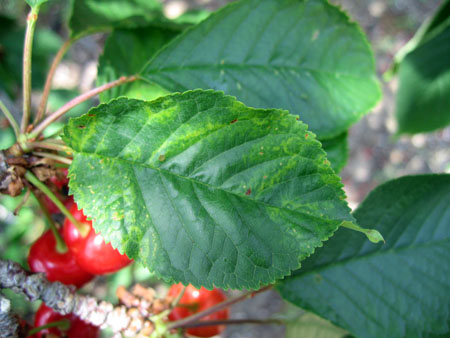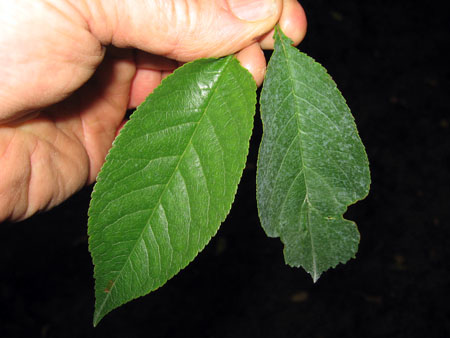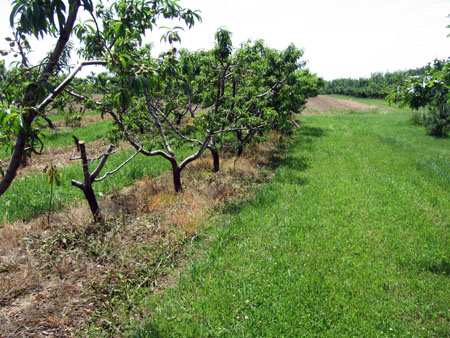Fruit trees in a “sea of viruses”
Michigan fruit orchards may have significant virus diseases without the owner being aware of the problem.
Three major viruses – tomato ring spot, prune dwarf, and necrotic ring spot – affect tree fruit orchards in Michigan by reducing yields and quality, tree health and tree longevity. There are many other viruses in fruit trees, but these are generally the most troublesome in Michigan. Although fruit from virus-infected tree fruit are perfectly safe for human consumption, these diseases are a problem for plant health and profitability. Tomato ring spot virus by itself and the combination of prune dwarf and prunus necrotic ring spot viruses together has been shown to greatly reduce the longevity of stone fruit orchards, depending on the variety and rootstock. The impact of a virus infection depends on the fruit type, the variety, and the rootstock. For example, Stanley plum is relatively tolerant of tomato ring spot virus on Mariana 2624 rootstock, but will decline within a few years if myrobolan rootstock is used. Apple trees will decline quickly if apple stem pitting virus-contaminated varieties are budded on G.16 rootstock.
These three viruses can persist in weeds, and, in the case of tomato ring spot virus, in the soil-borne dagger nematodes, causing problems for the next orchard planted in the same or adjacent sites. Tomato ring spot virus spreads easily in infected dandelion seed, and the dagger nematode, moves the virus from dandelion root to tree root, and visa versa. Prune dwarf and necrotic ring spot viruses are transmitted by pollen.
Although new nursery stock is generally free of these viruses, disease-free plants can become infected when planted in a site with a resident virus population in nearby trees or weeds, depending on the virus type. Persistence of the diseases is a real problem when preparing a site for a new planting. Viruses will also move from adjacent trees by root grafting.
A survey of 21 plum orchards in Michigan in the early 1990s by Michigan State University reported that all orchards tested had trees infected with tomato ring spot virus and that the percent of infected trees ranged from 4 to 82 percent. A more recent 2009 study of Berrien County stone fruit orchards revealed over 5 percent of trees sampled had detectable prune dwarf virus and 14 percent had prunus necrotic ring spot virus. Similarly, 48 percent of the samples (dandelions were sampled) from stone fruit orchards in the same region in 2010 were positive for tomato ring spot virus (W. Shane, Michigan Peach Sponsor Newsletter, 2009 & 2010). Some orchards had high levels of virus, while others had little or no detected virus.
Most growers are unaware if their orchard is in a virus “hot spot.” Diagnosis of these diseases by appearance alone is very difficult because the virus-induced symptoms often resemble those caused by nutritional disorders, root disorders, and other pathogens. The most reliable diagnosis is by testing plant tissue with ELISA and PCR laboratory tests. Previous work indicate that some tomato ring spot virus strains are difficult to detect in fruit tree leaf tissue, but can be more readily detected in the crown area roots and graft union tissue. Other studies have shown that dandelions are good hosts for the tomato ring spot virus and can be used as a proxy for quicker sampling. So, an important step in managing a potential virus problem is to find out if and to what extent various viruses are actually present. Local laboratory that will do ELISA assay for virus diagnosis include AgDia, Inc of Elkart, IL, (574-264-2615), and the MSU Diagnostic Services in East Lansing (517-355-4536). MSU Diagnostic Services will also do tests for the presence of dagger nematode.
Sampling for viruses is best done in the spring and early fall when cooler temperatures favor virus multiplication. Sampling and detection of dagger nematode is usually most successful in peak populations during late summer and before cool soils trigger nematode migration down into warmer soils.



 Print
Print Email
Email







